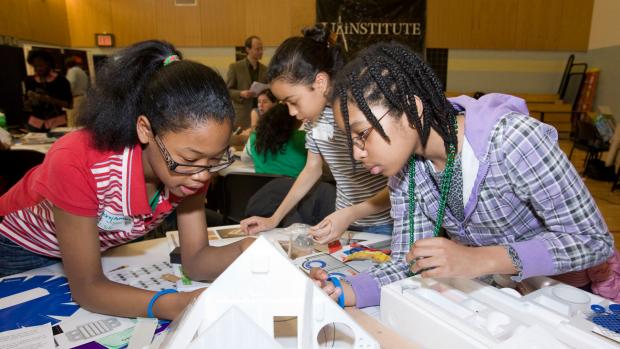At Green Expo Middle-School Students Learn ‘Engineering is in Everything’

“Helping the Earth,” quipped one young girl. Behind her a classmate waved a hand to respond, while another vied to be called on next. NYU-Poly undergraduate students at the front of the classroom had asked the group of middle-school students to define green engineering, and answers came faster than expected.
“They knew more than we did,” said Habeeb Shittu, a junior in NYU-Poly’s Department of Electrical and Computer Engineering. Together he and three classmates represented NYU-Poly’s student chapter of Engineers Without Borders at the Green Expo held last week on Earth Day at the Urban Assembly Institute (UAI) of Math and Science for Young Women. Sponsored by National Grid, which collaborated with NYU-Poly and UAI to organize the event, the exposition attracted students throughout New York City. Career panels, competitions, and presentations exposed them to professionals in various engineering fields — a positive outcome, said Mauri Myers-Solages, manager of corporate giving at National Grid.
“Engineering is so broad, it sounds scary,” she said. “Once you break it down, people understand that engineering is in everything.”
[GALLERY:3303|left]
That desire — to show how engineering infuses everyday life — characterizes the company’s goal of promoting science, technology, engineering, and mathematics (STEM) education. A report from the American Society for Engineering Education suggests the initiative is necessary: in 2007 bachelor’s degrees in engineering dropped for the first time since the 1990s, and in 2004 and 2005 undergraduate enrollment in the discipline noticeably decreased. The decline is predicted to continue, but many believe bolstering STEM-based education in the secondary grades can reverse the trend.
Nayana Niglye, a lead engineer at National Grid and a NYU-Poly alumna, said: “The students are at an impressionable age, and they can make a huge difference.”
She was on hand as a judge in the expo’s Green Home Contest, a competition requiring students to build a model eco-home with supplied materials. For Jill Fonda, a chemistry instructor at UAI, the contest diversified her teaching arsenal. “By partnering with NYU-Poly and National Grid, we bring in more resources,” she said. “We’re able to engage students in ways that a simple classroom setting doesn’t.”
Teams from UAI and the Agnes Y. Humphrey School for Leadership won the competition, but other students felt equally rewarded. Describing a career panel she attended, Elizabeth Adesanya, a ninth-grader at UAI, said, “It was really inspiring. Without people like that, we might not have some of the things we have today.”
Adesanya’s comments contributed to the gratitude expressed by Dr. Dianne Rekow, NYU-Poly provost, and Kiri Soares, co-principal at UAI. “We owe a debt of thanks to National Grid,” Dr. Rekow said, describing the company as a “true partner over the decades.”
Principal Soares seconded the cooperation between the three organizations: “We have the shared vision of encouraging STEM-based careers, which is why events like this are so important.”
Now an assistant professor in NYU-Poly’s Department of Chemistry, Jin Kim Montclare offered herself as an example of such efforts. Speaking at one of the expo’s career panels, she described how a high school teacher inspired her initial interest in the field and how important that influence had proven to be. “I grew up in the Bronx,” she told the audience of young New Yorkers. “I understand the need for mentors. If you’re not aware of these things, you just won’t bother.”





